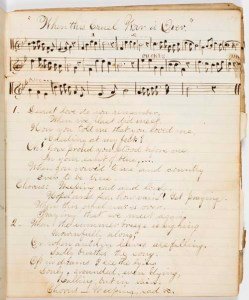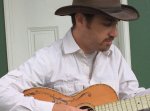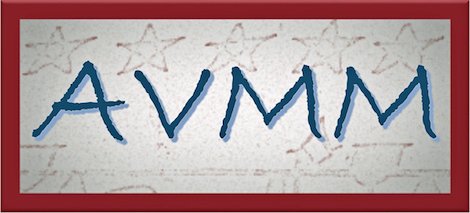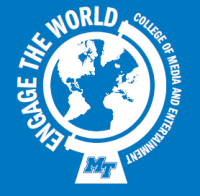
Charles Sanderson lived in Oak Hill, a villiage of Newton, Massachusetts. This song book, dated Dec. 29, 1866, contains handwritten music and lyrics. The Civil War songs, which are mostly about death and loss, include titles such as “When Johnny Comes Marching Home,” “O Wrap the Flag Around Me, Boys,” “The Vacant Chair” and “The Dying Soldier.”
The Center for Popular Music announced on March 18 the launch of its American Vernacular Music Manuscripts (AVMM) website.
Built as part of a three-year project funded by the National Endowment for the Humanities and undertaken in partnership with the American Antiquarian Society, the AVMM site makes available for the first time hundreds of American music manuscripts from the 1730s to 1910.
The project treats American manuscripts of vernacular music, covering a period from the Colonial era to the early 20th century. The complementary collections of the Center for Popular Music and the American Antiquarian Society are among the largest and most significant holdings of such material in the nation. Approximately 350 unique, handwritten manuscripts were included in the project, totaling more than 17,000 pages of music.
The manuscripts were all scanned in high resolution to archival standards for preservation, with the images stored at the Internet Archive. The AVMM website serves as a front page and search engine for the images, where users can search by year, song title, subject, origin, creator and keyword. In addition, all of the project manuscripts were cataloged in MARC library format, making them accessible through WorldCat, and a set of guidelines was created to allow other institutions to catalog similar manuscripts in their collections.
Dr. Greg Reish, director of the Center for Popular Music, notes that “the AVMM project makes available to everyone an overwhelmingly large collection of manuscripts that reveal what kinds of music Americans enjoyed at home before the advent of radio and recordings. Furthermore, the cataloging of these manuscripts was uncharted territory in the library and archival fields. What the project team accomplished will be of inestimable value not just to musicians and musical researchers, but also to other institutions who hold similar items and never knew how to deal with them.”
Irving Lowens (1916-1983) was born in New York City and graduated from Columbia University in 1939. For 15 years, he was employed by the Civil Aeronautics Administration and the Federal Aviation Administration. Lowens had a lifelong interest in American musicology, and in 1960, he began work in the Music Division of the Library of Congress. He was chief music critic for the Washington Evening Star from 1961 to 1978, and was a founding member of the Sonneck Society and the Music Critics Association. His publications include Music and Musicians in Early America (1964), Songsters Printed in America before 1821 (1976), and (with Allen P. Britton and Richard Crawford) American Sacred Music Imprints, 1698-1810 (1990). Lowens and his wife Margery Morgan Lowens shared an interest in the history of American music, and it was this interest that led Lowens to assemble an important collection of early American printed and manuscript music books. The Irving Lowens Collection was given to the American Antiquarian Society by Mrs. Lowens at her husband’s death. It includes 53 volumes containing manuscript music. Both sacred and secular music are well represented in this collection, which contains vocal as well as instrumental settings.
Dr. Thomas Knoles, curator of manuscripts at the American Antiquarian Society and AVMM project co-director, says, “Until now, repositories such as the American Antiquarian Society that had this material had no way to help researchers identify particular pieces of music in order to understand what tunes were in circulation and how widely they were copied.”
Dr. Dale Cockrell, former CPM director and AVMM project co-director, adds that “handwritten music manuscripts by common Americans contain primary and direct evidence of their musical preferences during a particular time and in a particular place. To see, play from or study one of these old manuscripts brings us as close to that person’s musical life as history allows.”
Senior Program Officer at the National Endowment for the Humanities Joshua Sternfeld says, “NEH is pleased that such a rich collection of early American materials, collaboratively produced, will not only reveal new insight into music-making but also shed light on the social and cultural fabric of communities, including ethnic traditions, social networks, religious practices, family life and class.”
For more information on the Center for Popular Music and its projects and special events, click here.




You must be logged in to post a comment.